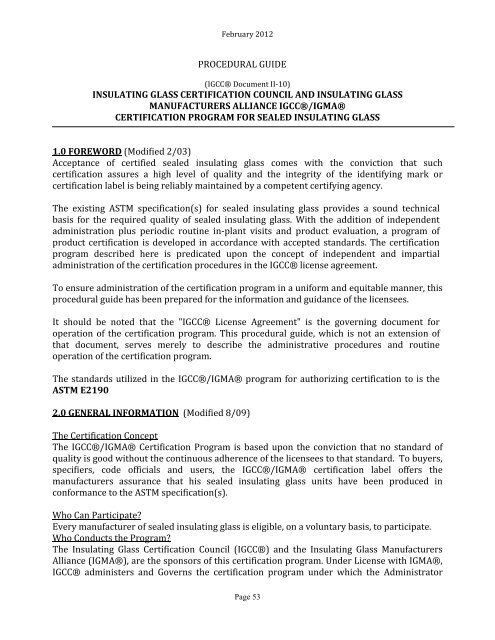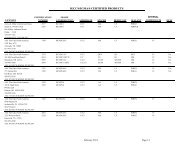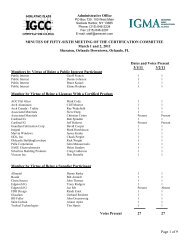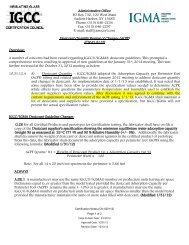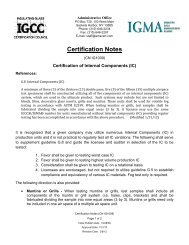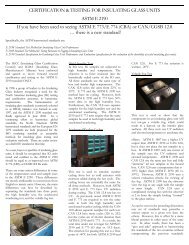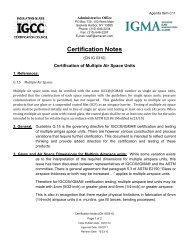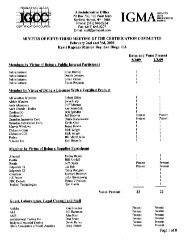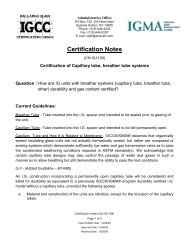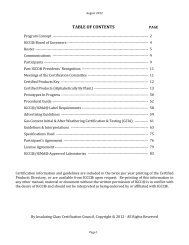Procedural Guide - Insulating Glass Certification Council (IGCC)
Procedural Guide - Insulating Glass Certification Council (IGCC)
Procedural Guide - Insulating Glass Certification Council (IGCC)
You also want an ePaper? Increase the reach of your titles
YUMPU automatically turns print PDFs into web optimized ePapers that Google loves.
February 2012<br />
PROCEDURAL GUIDE<br />
(<strong>IGCC</strong>® Document II-10)<br />
INSULATING GLASS CERTIFICATION COUNCIL AND INSULATING GLASS<br />
MANUFACTURERS ALLIANCE <strong>IGCC</strong>®/IGMA®<br />
CERTIFICATION PROGRAM FOR SEALED INSULATING GLASS<br />
1.0 FOREWORD (Modified 2/03)<br />
Acceptance of certified sealed insulating glass comes with the conviction that such<br />
certification assures a high level of quality and the integrity of the identifying mark or<br />
certification label is being reliably maintained by a competent certifying agency.<br />
The existing ASTM specification(s) for sealed insulating glass provides a sound technical<br />
basis for the required quality of sealed insulating glass. With the addition of independent<br />
administration plus periodic routine in-plant visits and product evaluation, a program of<br />
product certification is developed in accordance with accepted standards. The certification<br />
program described here is predicated upon the concept of independent and impartial<br />
administration of the certification procedures in the <strong>IGCC</strong>® license agreement.<br />
To ensure administration of the certification program in a uniform and equitable manner, this<br />
procedural guide has been prepared for the information and guidance of the licensees.<br />
It should be noted that the "<strong>IGCC</strong>® License Agreement" is the governing document for<br />
operation of the certification program. This procedural guide, which is not an extension of<br />
that document, serves merely to describe the administrative procedures and routine<br />
operation of the certification program.<br />
The standards utilized in the <strong>IGCC</strong>®/IGMA® program for authorizing certification to is the<br />
ASTM E2190<br />
2.0 GENERAL INFORMATION (Modified 8/09)<br />
The <strong>Certification</strong> Concept<br />
The <strong>IGCC</strong>®/IGMA® <strong>Certification</strong> Program is based upon the conviction that no standard of<br />
quality is good without the continuous adherence of the licensees to that standard. To buyers,<br />
specifiers, code officials and users, the <strong>IGCC</strong>®/IGMA® certification label offers the<br />
manufacturers assurance that his sealed insulating glass units have been produced in<br />
conformance to the ASTM specification(s).<br />
Who Can Participate?<br />
Every manufacturer of sealed insulating glass is eligible, on a voluntary basis, to participate.<br />
Who Conducts the Program?<br />
The <strong>Insulating</strong> <strong>Glass</strong> <strong>Certification</strong> <strong>Council</strong> (<strong>IGCC</strong>®) and the <strong>Insulating</strong> <strong>Glass</strong> Manufacturers<br />
Alliance (IGMA®), are the sponsors of this certification program. Under License with IGMA®,<br />
<strong>IGCC</strong>® administers and Governs the certification program under which the Administrator<br />
Page 53
February 2012<br />
periodically checks and reports compliance of the manufacturers of products having the<br />
<strong>IGCC</strong>®/IGMA® certification label.<br />
Administration<br />
Administrative Management Systems, Inc. (AMS) is the independent administrator of the<br />
certification program. AMS maintains the <strong>IGCC</strong>®/IGMA® office of certification and handles<br />
the routine day-to-day business. All transactions are done in the name of <strong>IGCC</strong>®/IGMA®.<br />
How Can You Become a Licensee?<br />
The following steps must be accomplished before <strong>IGCC</strong>®/IGMA® can authorize a<br />
manufacturer to use the <strong>IGCC</strong>®/IGMA® permanent label:<br />
a) The manufacturer must present a passing prototype report from an approved<br />
<strong>IGCC</strong>®/IGMA® testing laboratory to the office of certification. Fabrication of<br />
prototype test samples shall be witnessed by the Administrators representative during<br />
a plant audit, at which time the manufacturers compliance with <strong>IGCC</strong>®/IGMA® Quality<br />
Assurance requirements is validated. (See section 10.0)<br />
b) The manufacturer signs two copies of the <strong>IGCC</strong>® License Agreement and sends these<br />
to the office of certification. <strong>IGCC</strong>® will countersign both copies and return one to the<br />
licensee.<br />
c) The licensee sends the office of certification the necessary certification fee.<br />
d) After receipt by the office of certification of the above, the administrator validates that<br />
particular model and sends to the licensee a "Notice of Authorization to Use the<br />
<strong>IGCC</strong>®/IGMA® Permanent Label." The permanent label must be affixed on each<br />
certified sealed insulating glass unit.<br />
e) The certified model will then be listed in the next published Certified Products<br />
Directory.<br />
3.0 HOW THE CERTIFICATION PROGRAM WORKS (Modified 1/12)<br />
American Society for Testing and Materials has test methods and specifications for sealed<br />
insulating glass. Sealed insulating glass must meet or exceed the applicable specification<br />
before it can be certified.<br />
Recognized independent testing laboratories conduct all tests. The certification committee<br />
shall approve all laboratories, whose test reports are utilized by this certification program.<br />
As the sole judge of compliance with the applicable specifications, the administrator<br />
authorizes a product, which has been approved to be listed in the Certified Products<br />
Directory.<br />
Licensees label sealed insulating glass units in accordance with the labeling requirements<br />
established by the <strong>Certification</strong> Committee.<br />
Page 54
February 2012<br />
Approved products are listed in the Certified Products Directory, which is published every six<br />
months. It is sent to door, sash and building manufacturers, glazing contractors,<br />
homebuilders, architects, regulatory agencies and code-making groups, etc. Directory listings<br />
contain the licensee’s name, plant location and product description.<br />
The administrator verifies production at the licensee’s manufacturing location during twice<br />
per year audits. Audits are performed by a representative of the administrator. During each of<br />
these audits, the manufacturer’s compliance with <strong>IGCC</strong>®/IGMA® Quality Assurance<br />
requirements is validated (See section 10.0). The prototype test report must be submitted<br />
within one year of the repot date in order for the report to be considered as the test for the<br />
first year, two audits will take place at which time the auditor will compare current<br />
production with the product authorized to use the <strong>IGCC</strong>®/IGMA® permanent label. At the<br />
discretion of the administrator, when a licensee is located outside of North America and test<br />
sample fabrication is not required, one audit in a given year may be performed internally by<br />
personnel of the licensee. In this case the required audit information will be transmitted to the<br />
licensee’s internal auditor and upon completion reviewed by the administrator.<br />
During the first audit in the second year, specimens will be fabricated for testing.<br />
<strong>IGCC</strong>®/IGMA® will ask the manufacturer to produce a minimum of thirteen test specimens.<br />
The fabrication of these test specimens is witnessed and verifies that they are produced in<br />
accordance with the construction certified. During test specimen fabrication, only the<br />
<strong>IGCC</strong>®/IGMA auditor and employees of the licensee being audited shall be present. The<br />
licensee is instructed to send these test specimens to an approved <strong>IGCC</strong>®/IGMA® testing<br />
laboratory where they are tested. The specimens must be shipped to the laboratory within<br />
four weeks of fabrication. Tests are made at the laboratory recommended by the licensee and<br />
selected by the administrator from the approved list.<br />
A monthly report listing the status of testing is mailed to the licensee by the office of<br />
certification on the 15 th of each month. Upon completion of the test, the administrator mails<br />
results promptly to the licensee.<br />
After initial certification (Prototype) testing, ASTM E2190 testing shall occur annually for the<br />
first 2 years of certification. If no failures occur, then testing may occur once every 2 years, at<br />
the discretion of the participant.<br />
4.0 COMPLIANCE SAFEGUARDS (Modified 8/09)<br />
How is Compliance Assured?<br />
Any certified product found in the course of routine audit and evaluation not to be in<br />
compliance with the model description or quality assurance requirements is subject to having<br />
authorization to use the <strong>IGCC</strong>®/IGMA® permanent label removed. The licensee is sent a<br />
request for clarification giving thirty days in which to demonstrate to the satisfaction of the<br />
administrator that his product is in compliance with the model description that is certified. If<br />
he does not respond, a warning of possible removal of authorization to use the<br />
<strong>IGCC</strong>®/IGMA® permanent label is sent giving an additional thirty days to respond. If he does<br />
Page 55
February 2012<br />
not respond, authorization to use the <strong>IGCC</strong>®/IGMA® permanent label is automatically<br />
terminated at the end of that thirty-day period.<br />
In the case of a routine test failing to comply with the specifications, the licensee will be<br />
officially notified that within 15 days he must respond by stating that a retest fabrication is<br />
requested and by paying all administrative and test fees. If there is no response within the 15<br />
days, authorization to use the <strong>IGCC</strong>®/IGMA® permanent label is automatically terminated. If<br />
the retest option is accepted, the administrator will perform an audit and witness fabrication<br />
of the retest specimens within 45 days of payment of fees.<br />
Challenging a Certified Product<br />
Complaints of non-compliance from any corporation or business source will be investigated<br />
promptly upon receipt of the complaint in writing along with an appropriate surety deposit. A<br />
minimum surety deposit of $1,500 will be required for each complaint of non-compliance. The<br />
surety deposit will be assessed at the rate of $300 per man-day plus the reasonable cost of<br />
travel and other expenses entailed in resolving such incidents. Refunds of part or all of the<br />
surety deposit will be made when applicable. The surety deposit will cover all costs involved,<br />
unless the investigation proved non-compliance, in which case all costs will be borne by the<br />
licensee found to be in non-compliance.<br />
Complaints by Consumers<br />
The administrator shall receive and log the complaint. It will be the consumer's responsibility<br />
to identify the label, information appearing on the spacer of glass and advise the<br />
administrator of the same. Note: If no <strong>IGCC</strong>®/IGMA® label exists, the product has not been<br />
certified by the manufacturer to <strong>IGCC</strong>®/IGMA® and the administrator and <strong>IGCC</strong>®/IGMA®<br />
have no further responsibilities or options.<br />
Once the consumer has identified the label, name, etc. and advised the administrator, the<br />
administrator shall respond, advising the consumer of the name, address, primary contact,<br />
model description and other pertinent information at hand as it pertains to the subject<br />
licensee. Note: If the complaint is being made for reasons of product appearance or failure<br />
such as glass quality, fogging, seal failure, dust, etc., the consumer shall be advised to contact<br />
the licensee for manufacturer directly. Some manufacturers and their dealers or distributors<br />
offer warranties on their products. Normal claims, procedures and legal remedies are<br />
available to consumers on a state-by-state basis.<br />
If the consumer wishes to determine whether or not a labeled product is in compliance with<br />
the model described through an investigation by <strong>IGCC</strong>®/IGMA®, the corporation or business<br />
challenge procedure shall be utilized. The surety deposit shall be modified to $400 and<br />
charges per man-day and shall be assessed against the surety deposit in the amount of $300<br />
plus reasonable travel costs and other expenses.<br />
Withdrawal of Certified Product<br />
Any product which has been authorized to use the <strong>IGCC</strong>®/IGMA® permanent label may be<br />
voluntarily withdrawn from the <strong>Certification</strong> Program by the licensee at any time.<br />
Page 56
February 2012<br />
5.0 COSTS (Modified 8/09)<br />
What Does the Program Cost?<br />
The initial administration fee will be based on the date of authorization to use the<br />
<strong>IGCC</strong>®/IGMA® permanent label in a manner that participation in the <strong>Certification</strong> Program<br />
will be on a February 1 to January 31 basis thereafter. If the authorization date is between<br />
August 1 and December 1, 50% of the administration fee for the first year will be charged for<br />
participation and will include one audit prior to the following February 1 date. A licensee is<br />
invoiced for each item that is certified and listed separately in the Certified Products<br />
Directory. An additional invoice for testing laboratory fees will be issued upon fabrication of<br />
test units.<br />
Testing of these units will not begin until payment has been received. Should failure of these<br />
units occur during certification testing, any remaining balance will be refunded to the licensee<br />
upon request.<br />
6.0 DOCUMENTS AND AGREEMENTS (Modified 8/09)<br />
License Agreement<br />
This agreement, incorporating independent program administration and routine, periodic,<br />
independent plant audits, sampling and evaluation, governs the relationship between IGGC®<br />
and the licensee.<br />
Future amendments or revisions to the License Agreement will be recommended by the<br />
<strong>Certification</strong> Committee and enacted by the <strong>IGCC</strong>® Board of Governors.<br />
Effective Date, Duration, and Termination<br />
The License Agreement becomes effective on the date of its execution, has an initial duration<br />
of twelve months (adjustable to a February 1 to January 31 basis), and is automatically<br />
renewed for successive twelve month periods, unless either party gives notice, at least sixty<br />
days prior to date of expiration, that cancellation is requested or unless revoked by <strong>IGCC</strong>® for<br />
causes set forth in the document.<br />
Administrative Service Agreement<br />
This agreement entered into by <strong>IGCC</strong>® and Administrative Management Systems, Inc. (AMS)<br />
governs the relationship between <strong>IGCC</strong>® and AMS, the independent administrator. In general,<br />
it provides that the administrator:<br />
a) routinely audits licensee manufacturing facilities twice per year, and during the<br />
first audit in the second and subsequent years, witnesses fabrication of specimens<br />
for testing at one of the <strong>IGCC</strong>®/IGMA® approved testing laboratories,<br />
b) has the right to witness any and all testing,<br />
Page 57
February 2012<br />
c) reviews all test reports in order to determine compliance of the certified product<br />
with the specifications,<br />
d) audits and recommends for approval, all test laboratory facilities for use in this<br />
certification program; test laboratories are recognized or approved by the<br />
certification committee,<br />
e) publishes and mails the <strong>IGCC</strong>®/IGMA® Certified Products Directory twice each<br />
year and handles all routine clerical duties of <strong>IGCC</strong>®/IGMA® with respect to<br />
certification matters,<br />
f) acts as <strong>IGCC</strong>® treasurer, invoicing licensees, maintaining a bank account and<br />
dispersing funds (fiscal reports are made to the Board of Governors),<br />
g) attends all scheduled meetings of the <strong>Certification</strong> Committee, and<br />
h) in all of its actions acts in the name of <strong>IGCC</strong>®.<br />
<strong>IGCC</strong>®/IGMA® Administration Services and Exclusive Licensing Agreement<br />
This agreement defines the relationship where IGMA® and <strong>IGCC</strong>® desire to combine the<br />
administration and marketing of their two certification programs into one certification<br />
program administered and governed by <strong>IGCC</strong>® under which both the <strong>IGCC</strong>® Mark and the<br />
IGMA® Mark are licensed to certification program participants meeting the requirements<br />
(“<strong>IGCC</strong>®/IGMA® <strong>Certification</strong> Program”)<br />
<strong>Procedural</strong> <strong>Guide</strong><br />
This guide outlines program procedures in accordance with the provisions of the License<br />
Agreement and the Administrative Service Agreement, for the guidance of those concerned<br />
with the procedural details of the <strong>Certification</strong> Program's operation. It covers the steps to be<br />
taken in any given procedural situation in the interest of equitable and uniform treatment of<br />
licensees and the preservation of the integrity of the certification program.<br />
Certified Products Directory<br />
This directory is the one document and publication that is normally in the public's eye and<br />
contains a listing of the certified seal insulating glass units of each licensee.<br />
<strong>Certification</strong> Label<br />
The licensee permanently affixes this certification mark to each unit of certified sealed<br />
insulating glass. This certification mark may be reference to the Licenscee’s listing in the<br />
Certified Products Directory. The listing then provides a product description including the<br />
company name, plant location, etc.<br />
Page 58
February 2012<br />
7.0 PROGRAM RESPONSIBILITY (Modified 8/09)<br />
<strong>IGCC</strong>® Board of Governors<br />
The <strong>IGCC</strong>® Board of Governors has overall responsibility for the well-being and acceptance of<br />
the <strong>Certification</strong> Program by the industry, building officials and the public. It also bears legal<br />
corporate responsibility.<br />
IGMA® Board of Directors<br />
The IGMA® Board of Directors may make recommendations to the <strong>IGCC</strong>® Board regarding<br />
the <strong>IGCC</strong>®/IGMA® <strong>Certification</strong> Program and may appeal any decision of <strong>IGCC</strong>® regarding<br />
certification or the <strong>IGCC</strong>®/IGMA® <strong>Certification</strong> Program.<br />
<strong>IGCC</strong>® <strong>Certification</strong> Committee<br />
The <strong>IGCC</strong>® <strong>Certification</strong> Committee has the responsibility for the general procedure and<br />
policy pertaining to operation of the <strong>Certification</strong> Program. As a part thereof, it<br />
a) establishes "guidelines",<br />
b) determines the applicability of the specifications in a specific situation where a<br />
question is raised by a licensee or the administrator,<br />
c) approves test laboratories,<br />
d) determines which of the specifications are to be designated effective for the purposes<br />
of product certification and the date or dates on which they become effective, and<br />
e) recommends to the <strong>IGCC</strong>® Board of Governors changes to be made in the License<br />
Agreement.<br />
8.0 LABEL REQUIREMENTS (Modified 8/10)<br />
THE <strong>IGCC</strong>®/IGMA® CERTIFICATION LABEL MUST BE PERMANENTLY MARKED ON A<br />
VISIBLE PORTION OF EACH SEALED INSULATING GLASS UNIT OR IT IS NOT CERTIFIED BY<br />
THE MANUFACTURER TO THE PUBLIC. The label shall be etched, sand blasted, embossed,<br />
printed, Painted or otherwise permanently marked on the spacer or at least one component<br />
pane of the sealed unit. (See note #1 below)<br />
This label must be visible after installation in the building. The <strong>IGCC</strong>®/IGMA® permanent<br />
label must be in block capital letters and have a minimum height of 0.050 inches (1.27 mm).<br />
The letters <strong>IGCC</strong>®/IGMA® must be followed by the ® registration mark or a close facsimile,<br />
i.e., <strong>IGCC</strong>®/IGMA®. The <strong>IGCC</strong>®/IGMA® permanent label must contain the company<br />
identification (company name, trade name or company code), plant code*, registered<br />
"<strong>IGCC</strong>®/IGMA®" mark and a date code spanning no more than a 12 month period, plus or<br />
minus three months. The date code should commence with the beginning of each calendar<br />
year (effective for both the beginning and the ending of each period). Outdated spacers may<br />
be hand stamped to bring the label up to date. The plant code will only be required when<br />
there is more than one plant with an <strong>IGCC</strong>®/IGMA® certified product operating under the<br />
Page 59
February 2012<br />
same company name. The <strong>IGCC</strong>®/IGMA® permanent label must be affixed to certified<br />
products only at the time and place of manufacture. The labeling must be approved by the<br />
administrator. The permanent label must be affixed only to the sealed insulating glass units<br />
of the licensee's own manufacture which have been certified by the manufacturer through<br />
<strong>IGCC</strong>®/IGMA®.<br />
The permanent label must not be sold, transferred or otherwise disposed of in any manner<br />
other than being affixed to the licensee's certified production. The permanent label must not<br />
be affixed to any product from which certification has been withdrawn or which is produced<br />
with a process basically different from the one used when certification was obtained.<br />
Example of Minimum Label:<br />
ABC <strong>Glass</strong> Co.(*) <strong>IGCC</strong>®/IGMA® ‘10<br />
The <strong>IGCC</strong>®/IGMA® permanent label is listed under each company’s name in the “Certified<br />
Products” section of this directory.<br />
* A plant code will only be required when there is more than one plant with an<br />
<strong>IGCC</strong>®/IGMA® certified product operating under the same company name.<br />
Note#1:<br />
When an NFRC certified window, door, skylight fabricator also fabricates <strong>IGCC</strong>®/IGMA®<br />
certified IG units and glazes these IG units into their own NFRC certified product, the<br />
<strong>IGCC</strong>®/IGMA® permanent label may appear on the window, door, skylight NFRC permanent<br />
label in lieu of the <strong>IGCC</strong>®/IGMA® permanent label appearing on the actual IG unit.<br />
<strong>IGCC</strong>®/IGMA® required label content and NFRC permanent label requirements shall apply.<br />
For Example:<br />
NFRC 123 - N - 456<br />
-------------------------------------<br />
ABC Windows - Dallas <strong>IGCC</strong>®/IGMA® 2010<br />
9.0 ADVERTISING GUIDELINES (Modified 8/09)<br />
The following concepts are important to remember whether you are a participant, licensee in<br />
the <strong>IGCC</strong>®/IGMA® <strong>Certification</strong> Program, or a supplier to the sealed insulating glass<br />
industry. This discussion is intended to provide you with an accurate background description<br />
of the <strong>IGCC</strong>®/IGMA® <strong>Certification</strong> Program, to help you avoid making possibly misleading,<br />
deceptive, or ambiguous statements regarding the program in the advertising of your<br />
products.<br />
Page 60
February 2012<br />
1) <strong>IGCC</strong>®/IGMA® is the sponsor of a certification program. <strong>IGCC</strong>®/IGMA® does not<br />
certify products.<br />
2) The administrator audits laboratories and checks their equipment, audits licensees'<br />
production and fabrication of specimens, and validates test reports and certification<br />
claims.<br />
3) Laboratories test specimens to specific test methods and specifications referenced by<br />
<strong>IGCC</strong>®/IGMA®<br />
4) Manufacturers/licensees "certify" their products, affirming that their products are<br />
constructed similarly to specimens which were audited, tested and found to pass the<br />
stated criteria. A Licensee's <strong>Certification</strong> Statement is the imprinting, sandblasting,<br />
etching or other form of permanent marking of an <strong>IGCC</strong>®/IGMA® certification<br />
program designation and number to its product.<br />
5) The <strong>IGCC</strong>®/IGMA® <strong>Certification</strong> Program does not have "members," inasmuch as the<br />
term "members" carries with it a connotation that some detailed criteria must be met<br />
in order to participate in the organization. Under the <strong>IGCC</strong>®/IGMA® concept, anyone<br />
can participate and "participants" simply must possess a "legitimate interest in the<br />
purposes of <strong>IGCC</strong>®/IGMA®." Manufacturers, on the other hand, which are "fabricators<br />
of sealed insulating glass units," become participants by virtue of executing a License<br />
Agreement with <strong>IGCC</strong>®. Any manufacturer of insulating glass may voluntarily enter<br />
into a License Agreement, provided that they intend to certify at least one product<br />
under the <strong>IGCC</strong>®/IGMA® <strong>Certification</strong> Program. Thus, the proper term to use for a<br />
manufacturer participant is "Licensee." A manufacturer, with a prototype in progress,<br />
is termed a "Candidate Licensee."<br />
6) Unit specimens, not their components, are tested under the <strong>IGCC</strong>®/IGMA® program.<br />
Thus, if you are a supplier to the industry, statements indicating that your components<br />
have complied with the test methods would be incorrect. A better nomenclature for<br />
example, would be, that "Units tested to ASTM E2190 contained our X component<br />
have been found to meet the requirements of the specification(s)."<br />
7) Should you have any questions concerning the <strong>IGCC</strong>®/IGMA® <strong>Certification</strong> Program,<br />
please contact:<br />
<strong>Insulating</strong> <strong>Glass</strong> <strong>Certification</strong> <strong>Council</strong><br />
Mr. John G. Kent<br />
PO Box 730, 100 West Main Street<br />
Sackets Harbor, NY 13685<br />
Telephone: 315-646-2234<br />
Fax: 315-646-2297<br />
E-mail: staff@amscert.com<br />
Page 61
February 2012<br />
10.0 QUALITY ASSURANCE PROGRAM (Modified 8/09)<br />
<strong>IGCC</strong>®/IGMA® require licensees to have a working quality assurance program for the<br />
fabrication of insulating glass. As a minimum, the licensee’s quality assurance system must<br />
comply with the general requirements of IGMA TM 4000 which established 1) general<br />
requirements for quality systems and 2) provides practical solutions for implementing such a<br />
system. <strong>IGCC</strong>®/IGMA® requires compliance to these general requirements of IGMA TM 4000<br />
but does not define the specifics of the quality assurance system which should be appropriate<br />
for the type, range and volume of work performed.<br />
Adherence is verified during twice per year plant visits. These requirements were adopted to<br />
improve the overall quality of IG units in the program, and also to satisfy requirements<br />
established by the Department of Housing and Urban Development, HUD, the National<br />
Fenestration Rating <strong>Council</strong> (NFRC) and other regulatory and consumer driven organizations.<br />
A licensee’s QA program shall comply with IGMA TM 4000 which establishes requirements for<br />
the following:<br />
1) A quality systems manual<br />
2) A designated person responsible for quality assurance<br />
3) Process Control<br />
4) Inspection and Testing (Spacer, Desiccant, Sealant, Gas Fill, Finished Product, <strong>Glass</strong>)<br />
5) Calibration<br />
6) Non-Conforming Products and Corrective Action<br />
7) Storage and Handling<br />
8) Field Service<br />
9) Internal Quality Audits<br />
10) Training<br />
11) Statistical Techniques<br />
11.0 GAS CONTENT INITIAL AND AFTER WEATHERING CERTIFICATION AND TESTING<br />
(GCIA) (Modified 8/10)<br />
A licensee must certify to seal durability requirements to participate in the gas content<br />
program. The <strong>IGCC</strong>®/IGMA® Gas Content program is voluntary if gas content units<br />
will NOT use <strong>IGCC</strong>®/IGMA® marked spacer, but is mandatory if <strong>IGCC</strong>®/IGMA®<br />
marked spacer will be used for gas content units. The program is intended to<br />
demonstrate a licensee’s ability to initially fill to a minimum level and the ability of the<br />
construction of the IG unit to retain a minimum gas content level after exposure to the<br />
ASTM E2190 weathering cycle.<br />
Licensees meeting a tested initial gas content of 90% or greater and a final after<br />
weathering gas content of 80% or greater shall be identified in the Certified Products<br />
Directory (CPD) with the designation “GCIA” for “Gas Content, Initial and After<br />
Page 62
February 2012<br />
Weathering”. Both initial and after weathering gas content must be compliant in order<br />
to be listed as “GCIA”. The gas content certification process will be as follows:<br />
1. The normal minimum of twelve (13) 14x20-inch (355x505 mm) test units for<br />
seal durability, fourteen (15) for multiple air space units, shall be fabricated<br />
under auditor witness during normal durability certification fabrication audits.<br />
All test units shall be gas filled with argon. All multiple air space units shall have<br />
both cavities filled and tested. Per guideline G.19 as applicable, coated glass<br />
shall be used and multiple air space units shall have coated glass as the center<br />
lite for at least ten (10) test units intended for testing in accordance with ASTM<br />
E2188 and have coated glass on at least one outer lite for at least four (4) test<br />
units intended for testing in accordance with ASTM E2189. The test lab shall<br />
randomly select ten (10) units for initial gas content testing except that units<br />
containing internal components (IC) (i.e. grills or muntins) shall not be<br />
considered for testing. Units shall be inspected for any damage, and any<br />
damaged units not used. Testing for gas content after weathering shall be<br />
performed on the six (6) ASTM E2190 weathering test units.<br />
2. Production Units – As of 6/23/10 selection and testing of production units is<br />
not required.<br />
3. Units shall be tested for initial and after weathering gas content percent by nondestructive<br />
spark emission spectrography (SES) in accordance with ASTM<br />
E2649 Determining Argon Concentration in Sealed <strong>Insulating</strong> <strong>Glass</strong> Units Using<br />
Spark Emission Spectroscopy. Up to two (2) test units (14” x 20”) may be used<br />
to replace any unit broken in shipping or handling.<br />
4. Laboratories shall report results of testing as “percent initial gas content” and<br />
“percent after weathering gas content” to the nearest whole percent.<br />
5. The calculation of percent initial gas content shall be the average of all ten (10)<br />
units tested. The calculation of percent after weathering gas content shall be<br />
the average of all six (6) weathered test units.<br />
6. To be listed as complying with gas content certification, initial and after<br />
weathering (GCIA) the average gas content level must be 90% or greater<br />
initially and 80% or greater after weathering, and each of the tested units shall<br />
have a gas concentration of 50% or greater . These levels were selected as<br />
levels that can reasonably be reached by insulating glass fabricators on a<br />
consistent basis. It takes into consideration a) variations that may occur in the<br />
filling process, and b) variations that may occur in the testing process. If a<br />
licensee feels that its gas content is consistently greater than these gas content<br />
values, the licensee can include this information in the licensee’s literature.<br />
Page 63
February 2012<br />
7. It is recognized that actual production units may not necessarily be 90% or<br />
greater initial gas content but shall meet the manufacturer’s stated initial<br />
content values.<br />
8. Special arrangements need to be made if regulatory compliance is required for<br />
gas content other than argon (see certification guideline A.GC.1).<br />
12.0 CERTIFICATION GUIDELINES AND INTERPRETATIONS<br />
For guidance in labeling and certifying sealed insulating glass units the <strong>Certification</strong><br />
Committee has adopted the below guidelines.<br />
Additionally, certain topics that required added explanation and clarification have been<br />
presented in a series of <strong>Certification</strong> Notes as referenced. These <strong>Certification</strong> Notes are<br />
available on the <strong>IGCC</strong>®/IGMA® website (www.igcc.org) or by contacting the administrative<br />
office.<br />
ID # Title Initial Publish<br />
Date<br />
Approval<br />
Date<br />
CN IG 1009 <strong>Certification</strong> of Internal Components (IC) 10/28/09 1/31/12<br />
CN IG 1109 <strong>Certification</strong> of Capillary Tube, Breather 10/28/09 10/28/09<br />
Tube Systems<br />
CN IG 0310 <strong>Certification</strong> of Multiple Air Space Units 3/1/10 3/2/11<br />
CN IG 1010 Interim <strong>Certification</strong> 10/14/10 3/1/11<br />
CN IG 0211 <strong>Certification</strong> and Testing of Vacuum<br />
<strong>Insulating</strong> <strong>Glass</strong> VIG<br />
2/18/11 1/31/12<br />
ALWAYS<br />
12.1 The following situations permit the licensee to always certify the sealed insulating glass<br />
units with the same <strong>IGCC</strong>®/IGMA® number.<br />
12.1.1 GLASS<br />
A.GL.1<br />
Any change in glass thickness from that tested. (Modified 3/15/06)<br />
A.GL.2<br />
Any change in glass tint or color from that tested (clear glass is required in test specimens).<br />
A.GL.3<br />
Any change in glass size from that tested (14 by 20 inches is required for test specimens).<br />
Page 64
February 2012<br />
A.GL.4<br />
Any change in glass type (i.e. tempered, heat strengthened, laminated or patterned glass) from<br />
that tested (annealed glass is normally used in all test specimens).<br />
A.GL.5<br />
Any change in glass shape from that tested (rectangular glass is required in test specimens).<br />
This guideline permits the same <strong>IGCC</strong>®/IGMA® number for triangular, circle head,<br />
trapezoidal and other shapes.<br />
A.GL.6<br />
Any change in glass supplier from that tested.<br />
A.GL.7 (Deleted 3/15/06)<br />
A.GL.8 (Deleted 3/15/06)<br />
A.GL.9 (Deleted 3/2/11)<br />
12.1.2 SPACER<br />
A.SP.1<br />
Any change in air space dimension from that tested (one-quarter inch to one-half inch air<br />
space is allowed for testing).<br />
A.SP.2<br />
Any change in spacer wall thickness from that tested.<br />
A.SP.3<br />
Any change in spacer seam design (i.e. butt seam or lock seam) from that tested.<br />
A.SP.4<br />
Any change in supplier of spacer from that tested, everything remaining the same.<br />
A.SP.5<br />
Corners or connections which are soldered, welded, brazed or bent, but uncut, may be used<br />
interchangeably with the same <strong>IGCC</strong>®/IGMA® number. (Adopted 2/19/85)<br />
A.SP.6<br />
Corners or connections may be changed from mechanical connections (MS) to bent-uncut<br />
corners (BC), using the same <strong>IGCC</strong>®/IGMA® number utilizing joiners or corner keys of<br />
plastic, aluminum, stainless, or galvanized steel. (Adopted 10/18 /89, modified 5/14/08)<br />
A.SP.7<br />
Any change in spacer profile from that tested. (Adopted 7/29/04)<br />
Page 65
February 2012<br />
12.1.3 INTEGRATED SPACER SYSTEMS<br />
Defined as a a pre-fabricated multi-component, multi-material and/or multi-function spacer<br />
system. Contact the <strong>IGCC</strong>®/IGMA® Administrative Office for the most current list of reviewed<br />
integrated spacer systems and their generic class.<br />
A.SS.1<br />
A licensee may certify a thermally broken Integrated Spacer System (ISS) on the<br />
"<strong>IGCC</strong>®/IGMA® List of Reviewed Integrated Spacer Systems" utilizing the same <strong>IGCC</strong>®GMA®<br />
number as the base spacer generic material (single homogeneous component) provided<br />
regular test units include the thermally broken ISS, all other guidelines applicable. (Adopted<br />
1/31/12)<br />
A.SS.2<br />
A licensee may use a temporary alternate integrated spacer system on the <strong>IGCC</strong>®/IGMA® list<br />
of reviewed integrated spacer systems (most current version) in the same generic class by a)<br />
notifying the administrator of the change, b) having test specimens witnessed by the<br />
administrator’s representative at the next regular audit, and c) sending the test specimens to<br />
an <strong>IGCC</strong>®/IGMA® approved testing laboratory within four weeks of the test specimens'<br />
fabrication date. However, <strong>Guide</strong>line G.26 shall apply where applicable. The licensee may<br />
temporarily use the certification label on a provisional basis commencing with written<br />
notification of the administrator and end when test results are received by the administrator.<br />
(Adopted 11/23/09, Modified 1/31/12)<br />
12.1.4 DESICCANT<br />
A.DE.1<br />
A manufacturer may use the same <strong>IGCC</strong>®/IGMA® number for units fabricated having air<br />
space equal to, or greater than 1/4-inch, provided the weight of desiccant per inch of<br />
perimeter edge remains the same or is greater than the model tested. On units fabricated<br />
having 3/16-inch air spaces, a manufacturer may use the same certification number, provided<br />
the manufacturer maintains the same weight of desiccant per inch of perimeter edge or as<br />
close to that value as possible. (Modified 7/28/99)<br />
A.DE.2<br />
A change in supplier of the same generic type of desiccant from that tested will not require a<br />
different <strong>IGCC</strong>®/IGMA® number.<br />
A.DE.3<br />
The use of the same desiccant manufactured in different particle size ranges will not require a<br />
different <strong>IGCC</strong>®/IGMA® number.<br />
Page 66
February 2012<br />
A.DE.4<br />
An increase in the percentage of molecular sieve in a blended desiccant up to a maximum of<br />
75% (defined as a "molecular sieve/silica gel" mix) will not require retest. Blends containing<br />
more than 75% molecular sieve shall be considered as molecular sieve desiccants and<br />
changes from these high sieve content blends (>75%) to 100% molecular sieve desiccants will<br />
not require retest. (Adopted 8/29/84, Modified 8/15/08)<br />
A.DE.5<br />
A licensee may change supplier of desiccant matrix provided that the licensee 1) immediately<br />
informs the administrator of the change, 2) provides written documentation that the<br />
adsorption capacity per perimeter edge of seal is equal to or greater than the matrix used in<br />
the original model, and 3) prepares test specimens at the time of the next scheduled<br />
inspection. (Adopted 4/29/97)<br />
A.DE.6<br />
Desiccant blends having more than 75% molecular sieve and less than 25% silica gel shall be<br />
considered as molecular sieve desiccants and fabricators may switch from the high molecular<br />
sieve content blends to 100% molecular sieve without retesting prior to their normal model<br />
certification test schedule. (Adopted 5/14/08)<br />
12.1.5 SEALANT<br />
A.SE.1<br />
Any increase in moisture vapor transmission path length is an acceptable alternate for<br />
labeling.<br />
A.SE.2<br />
A licensee may use a temporary alternate sealant on the <strong>IGCC</strong>®/IGMA® list of reviewed<br />
sealants (most current version) in the same generic class by a) notifying the administrator of<br />
the change, b) having test specimens witnessed by the administrator’s representative at the<br />
next regular audit, and c) sending the test specimens to an <strong>IGCC</strong>®/IGMA® approved testing<br />
laboratory within four weeks of the test specimens' fabrication date. The licensee may<br />
temporarily use the certification label on a provisional basis commencing with written<br />
notification of the administrator and end when test results are received by the administrator.<br />
(Modified 6/23/10)<br />
12.1.6 GAS CONTENT<br />
A.GC.1 (Deleted 3/2/11)<br />
Page 67
February 2012<br />
NEVER<br />
12.2 The following situations never permit the licensee to certify with the same<br />
<strong>IGCC</strong>®/IGMA® number. They require the use of a different <strong>IGCC</strong>®/IGMA® number.<br />
12.2.1 SPACER<br />
N.SP.1<br />
A change in spacer material, i.e. aluminum to steel or any other material will require a<br />
different <strong>IGCC</strong>®/IGMA® number.<br />
N.SP.2<br />
A change in spacer surface finish, i.e. anodized to mill finish or hot dip to electro galvanized<br />
will require a different <strong>IGCC</strong>®/IGMA® number.<br />
N.SP.3<br />
A change in corner design from soldered, welded, braised or bent(BC) to mechanical<br />
corner(MC) will require a different <strong>IGCC</strong>®/IGMA® number. (Modified 5/14/08)<br />
N.SP.4<br />
A change in corner key material to another material, except to the same material as the spacer,<br />
will require a different <strong>IGCC</strong>®/IGMA® number. All plastic keys and joiners are considered<br />
generically equivalent. This guideline does not apply to A.SP.6. (Modified 5/14/08)<br />
N.SP.5<br />
If bent, uncut spacer corners or connections(BC) are changed to mechanically fastened spacer<br />
corners(MC); a new <strong>IGCC</strong>®/IGMA® number is required. (Adopted 2/19/85, Modified<br />
5/14/08)<br />
12.2.2 DESICCANT<br />
N.DE.1<br />
A change in generic type of desiccant will require a different <strong>IGCC</strong>®/IGMA® number. Generic<br />
types, for purpose of this guideline are molecular sieve, and blends of silica gel and molecular<br />
sieve up to 75% by weight molecular sieve. Blends containing more than 75% molecular sieve<br />
shall be classified as a molecular sieve generic type of desiccant. (Adopted 8/29/84, Modified<br />
8/14/08)<br />
12.2.3 SEALANT<br />
N.SE.1<br />
In a single sealant system, a change in generic type of sealant will require a different<br />
<strong>IGCC</strong>®/IGMA® number.<br />
Page 68
February 2012<br />
N.SE.2<br />
In a two sealant system, a change in generic type of primary sealant will require a different<br />
<strong>IGCC</strong>®/IGMA® number.<br />
N.SE.3<br />
In a two sealant system, a change in generic type of secondary sealant will require a different<br />
<strong>IGCC</strong>®/IGMA® number.<br />
N.SE.4<br />
Any decrease in the minimum design moisture vapor transmission path length will require a<br />
different <strong>IGCC</strong>®/IGMA® number.<br />
N.SE.5<br />
Any increase in thickness of design moisture vapor transmission path (glass to spacer<br />
dimension) will require a different <strong>IGCC</strong>®/IGMA® number.<br />
12.3 CLASS I - UNIT MODIFICATION<br />
DEFINITIONS<br />
GENERAL<br />
Breather Tube - Tube inserted into the I.G. spacer and intended to be sealed prior to glazing of<br />
the unit.<br />
Capillary Tube - Tube inserted into the I.G. spacer and intended to be left permanently open.<br />
Capillary, Tube and How It Is Related to Membrane - <strong>IGCC</strong>®/IGMA® observes that organically<br />
sealed insulating glass units are not actually hermetically sealed, but rather are composed of<br />
sealing systems which demonstrate sufficiently low water and gas transmission rates as to<br />
pass the accelerated weathering conditions imposed in ASTM standard(s). We acknowledge<br />
that certain capillary tube designs may also control the passage of water and gases in such a<br />
manner as to allow breathing but still demonstrate the ability to pass the test conditions.<br />
G.0 - (Added <strong>Guide</strong>line – 8/14/85, Revised 10/28/09)<br />
An I.G. construction incorporating a permanently open capillary tube will be considered and<br />
listed for durability as equivalent to a previously <strong>IGCC</strong>®/IGMA® program durability certified<br />
I.G. model without a capillary tube, provided the following applies:<br />
a. Material and construction of the units are identical, except for the inclusion of the<br />
capillary tubes.<br />
b. Both sets of I.G. units reach the same performance level when tested according to<br />
ASTM standard(s). The units with capillary tubes need only be tested once.<br />
Page 69
February 2012<br />
c. The test must be run by an <strong>IGCC</strong>®/IGMA® approved lab. Unit installation instruction<br />
must be supplied to the lab.<br />
d. Preparation of test specimens need not be witnessed. However, the test result must be<br />
reviewed and approved by the administrator.<br />
G.1 Breather Tube (Temporarily Open Type)<br />
A licensee is permitted to insert the open end of a breather tube in a bag or container of<br />
desiccant during shipment of a specimen to the test laboratory for durability testing. The<br />
breather tube must be sealed prior to testing. (Adopted 8/14/85) Unit installation/sealing<br />
instruction must be supplied to the lab. (Revised 10/28/09)<br />
G.2 Breather Tube (Temporarily Open Type)<br />
The addition of a breather tube is acceptable, for shipping only, even though not in the<br />
durability test specimen. The breather tube should be properly sealed before installation.<br />
(Adopted 8/14/85) Unit installation/sealing instructions must be supplied to the lab.<br />
(Revised 10/28/09)<br />
G.3 Edge Protection<br />
The addition of edge protection such as metal banding, metallic foil, barrier coat, etc., is<br />
acceptable with the same <strong>IGCC</strong>®/IGMA® number.<br />
G.7 (Deleted 1/1/07)<br />
G.8 Internal Components (IC)<br />
A minimum of three (3) of the thirteen (13) double pane, five (5) of the fifteen (15) multiple<br />
airspace test specimens shall be constructed utilizing all of the components of an internal<br />
components (IC) system, which are used in the ultimate product. Such systems may include<br />
but are not limited to blinds, films, decorative glass inserts, grills and muntins. These units<br />
shall be used for volatile fog testing in accordance with ASTM E2189. When testing muntins or<br />
grills, test samples shall be fabricated dividing the sample into nine equal areas (3 by 3). A<br />
licensee may use the same <strong>IGCC</strong>®/IGMA® number for units manufactured without internal<br />
components (IC) providing regular testing has been accomplished in accordance with the<br />
above procedure. (Modified 1/31/12)<br />
G. 15 Multiple Air Spaces<br />
Multiple air space units may be certified with the same <strong>IGCC</strong>®/IGMA® number as single air<br />
space units, provided that the construction of each space complies with the guidelines for<br />
single space units; pressure communication of spaces is permitted, but not required. This<br />
guideline shall apply to multiple air space products that use glass or a suspended coated film<br />
(SCF) as an airspace barrier. Testing of multiple air space units shall be performed initially<br />
and in lieu of single air space unit testing at least once each (4) years. When testing multiple<br />
air space units with coated glass, the coated glass shall be on at least one outer lite for the<br />
units intended to be tested for volatile fog in accordance with ASTM E2189. (Modified<br />
6/23/10)<br />
Page 70
February 2012<br />
G. 17 (Deleted 1/1/07)<br />
G. 18 (Deleted 1/1/07)<br />
G. 19 Coated <strong>Glass</strong><br />
An <strong>Insulating</strong> glass unit constructed with coated glass with the coating toward the air space<br />
(pyrolytic or sputter coated) shall be certified utilizing the same <strong>IGCC</strong>®/IGMA® number<br />
provided regular test units include one lite of the coated product per test sample. Only the<br />
highest volume coated product need be tested. Testing of sputter coated non-edge deleted will<br />
cover sputter coated edge deleted, Pyrolytic and uncoated (clear). Testing of sputter coated<br />
edge deleted will cover Pyrolytic and uncoated. Testing of Pyrolytic will cover Pyrolytic and<br />
uncoated. Testing uncoated (clear) will only cover uncoated (clear). When testing multiple air<br />
space units with coated glass, the coated glass shall be on at least one outer lite for the units<br />
intended to be tested for volatile fog in accordance with ASTM E2189. (Modified 6/23/10)<br />
G.26 Desiccant in 1/2-inch Air-Space Test Units<br />
In cases where units are made for testing with 1/2-inch air-space, glass thickness shall remain<br />
within the guidelines already established and that the desiccant quantity shall be limited to a<br />
maximum of filling one-half of the perimeter. (Adopted 8/28/86) However, if equivalent<br />
desiccant quantity to a standard 1/4-inch air space unit can be demonstrated, filling of all<br />
sides will be allowed. (Modified 9/1/87)<br />
It should be noted that the limitation upon desiccant quantity is done in order to maintain the<br />
relationship of quantity of desiccant within the 1/2-inch air space test unit identical with that<br />
of a 1/4-inch air space test unit since the moisture vapor transmission area in each of these<br />
units is identical. Filling 4 spacers of a 1/2-inch air space would give manufacturers having<br />
this larger air-space unit tested an unfair advantage. It was asked to point out that testing of<br />
units containing a 1/2-inch air space will undergo greater stress during the test and,<br />
therefore, is considered a more difficult test in this configuration. (Adopted 8/28/86)<br />
G.27 Structural Modification, i.e. Hole for Gas Fill<br />
A sealed insulating glass unit that has been structurally modified, i.e. hole or holes for gas<br />
filling, shall be tested regularly for certification assembled with standard production<br />
procedures including these modifications. At the option of the manufacturer, the units may be<br />
tested with gas or air in the inter-space. Non-gas-filled units shall be considered equivalent<br />
providing construction is identical except for the omission of the gas filling hole/holes. To<br />
accommodate this modification a nominal l/2 inch ± 1/16 inch gas or air space maybe tested<br />
under this guideline. (Modified 7/31/01)<br />
G.29 IG Integrated Sash Technology<br />
When testing <strong>IGCC</strong>®/IGMA® units using IG Integrated Sash Technology, IG fabricators would<br />
have the option of testing integrated IG units in one of two methods: 1) glass size shall be<br />
14x20-inch and the sash shall be cut away to fit in a 14x20-inch testing opening, or 2) a larger<br />
sash which accommodates 14x20-inch glass may be tested. This option would need to be<br />
reviewed with the test lab ahead of time to ensure the test chamber can accommodate the<br />
larger sash size. All testing is completed with no glazing beads and all fabrication holes or<br />
Page 71
February 2012<br />
simulated hole punches in place. If the sash is cut away, this function must be performed by<br />
the IG fabricator. (Adopted 5/3/05)<br />
G.30 Applied Surface Coatings to an IG Spacer and Spacer Components<br />
An insulating glass unit utilizing an applied surface coating to an IG spacer and spacer<br />
components shall be initially certified under the normal certification testing process. The<br />
application of the coating will be documented in the product audit report. A surface coating<br />
may be added to or removed from an already certified product utilizing the same certification<br />
number by applying guideline G.5. Applied surface coatings would include, but not be limited<br />
to paints, coatings and adhesion promoters. Spacer and spacer components with an<br />
embedded or etched into the surface color are not subject to this guideline and may be<br />
certified with the same <strong>IGCC</strong>®/IGMA® number. (Adopted 5/14/08, Modified 3/2/11)<br />
G.32 GCIA and Capillary and Breather Tubes and Systems<br />
(Refer to guideline(s) G.0, G.1, G.2) An IG construction incorporating a permanently or<br />
temporarily open system or tube, (Capillary, breather or other) may be Gas Content Initial<br />
and After Weathering certified (GCIA) with the same <strong>IGCC</strong>®/IGMA® number provided<br />
regular test units include all the components of the system or tubes. Unit installation and/or<br />
sealing instructions must be supplied to the laboratory.<br />
G.34 Bent or Curved IG Units<br />
Special note should be taken that the ASTM E2190 test method does not provide for testing of<br />
Bent or Curved IG units. As such, it is only flat IG units that fall within the <strong>IGCC</strong>®/IGMA®<br />
<strong>Certification</strong> Program. This, however, in no way precludes the ultimate use of Bent or Curved<br />
IG units. Labeled spacer may be used in IG units, other than flat glass, bit in that case,<br />
certification does not apply. (Adopted 3/2/11)<br />
12.4 CLASS II - SPECIMEN<br />
G.6 Specimens – Quantity (Modified 8/23/07)<br />
No more than 4 additional test units shall be labeled by the auditor for testing (12 units<br />
required for double pane and 14 units required for multiple air space.) When gas content<br />
testing (GCIA), ship the additional auditor “labeled” units to the testing laboratory.<br />
G.9 Specimens - Production<br />
When a licensee is producing only unlabeled units at the time of a plant audit, the licensee will<br />
be requested by the <strong>IGCC</strong>®/IGMA® inspector to label at least one unit in accordance with<br />
<strong>Guide</strong>line G.7 to permit completion of the audit. (The label may be hand scribed or crayon<br />
marked on the inside surface.)<br />
G.10 Specimens - Production<br />
If a licensee is not producing units at the time of an audit a labeled unit from inventory may be<br />
cut apart for inspection, provided that the date code is within the audit period.<br />
Page 72
February 2012<br />
G.11 Specimens - Production<br />
A portion of the audit will be used to determine whether a licensee is using the<br />
<strong>IGCC</strong>®/IGMA® label on unauthorized units.<br />
G.12 Specimens - Shipment<br />
Units fabricated for test during an audit must be shipped directly to the approved test facility<br />
within four weeks of the date of fabrication. If they are not, the audit may be considered<br />
invalid and another audit must take place. But for normal in plant quality inspection processes<br />
performed by the manufacturer, there shall be no ‘pre-testing’ of any test sample being<br />
forwarded to the approved test facility. In situations where fabricated test units are deemed<br />
unacceptable for test by the licensee as a result of a normal plant quality inspection process,<br />
the licensee shall be allowed to re-fabricate test samples only once. This re-fabrication must<br />
occur within 45 days of the original fabrication. All costs related to this guideline are to be<br />
borne by the licensee. (Modified 5/14/08)<br />
G.14 Specimen Frequency<br />
The prototype test will be considered as the test for the first year of certification (providing<br />
application is made within 18 months from the date of the test report). This is effective for<br />
matters initiated after May 1982. The next fabrication for testing purposes will be in the first<br />
half of the second year.<br />
G.31 Suspension of Testing<br />
There may be situations where the program participant wishes to suspend testing (gas or<br />
durability) before completion. For prototype fabrications this shall be at the discretion of the<br />
program participant and has no effect on the certification listing. For certified unit testing,<br />
with consideration for guideline G.12, any suspension of the test, gas or durability, shall be<br />
deemed as a failure of that portion of the test. G.12 would not be applicable once testing has<br />
started. (Adopted 5/14/08)<br />
12.5 CLASS III - EQUIVALENCY<br />
G.5 Gray Area<br />
Situations that are not included in the "Always" or "Never” categories listed above, fall into the<br />
gray area. The gray area situation is covered by Minutes item 10.10.77.10 and is repeated<br />
here.<br />
When there is a change and the licensee desires to use the same <strong>IGCC</strong>®/IGMA® number, the<br />
licensee shall immediately notify the administrator with all details of the change and also<br />
satisfy either 1 or 2 below:<br />
1) establish equivalency by passing the same level of ASTM test as certified to by:<br />
a) having specimens tested at an <strong>IGCC</strong>®/IGMA® independent testing laboratory<br />
or<br />
Page 73
February 2012<br />
b) having specimens tested at an in house (licensee) facility, testing done in house<br />
by a licensee must be done under the surveillance of the administrator.<br />
Specimens must be fabricated and submitted to the laboratory within two weeks after<br />
notification of the administrator. During the test period, the licensee may temporarily<br />
use the certification label on a provisional basis or:<br />
2) demonstrate the equivalency of the change to the satisfaction of the <strong>Certification</strong><br />
Committee or a subcommittee. (Specimens not required.)<br />
G.21 Transfer<br />
If a licensee manufactures the same model using the same technology at a different location, a<br />
<strong>IGCC</strong>®/IGMA® number with a temporary status will be issued provided that testing<br />
(durability and/or gas content) of the model is initiated at the next scheduled testing audit.<br />
This guideline may not be applied to products for which certification has been previously<br />
removed due to test failure. (Modified 12/06/06)<br />
G.23 Equivalency<br />
A licensee needs to establish equivalency for a model only once.<br />
G.24 Vision <strong>Glass</strong> Areas<br />
Special note should be taken that the ASTM E2190 test method only provides testing for<br />
"Vision glass areas." As such, it is only these types of units that fall within the <strong>IGCC</strong>®/IGMA®<br />
<strong>Certification</strong> Program. This, however, in no way precludes the ultimate use of these units in<br />
other applications, e.g. Spandrel units.<br />
(Adopted 8/28/86) Labeled spacer may be used in IG units, other than vision glass, but in<br />
that case, certification does not apply. (Adopted 4/16/91)<br />
G.28 Certifying Additional Constructions<br />
A current licensee with currently certified products may certify additional constructions or<br />
replace a certified construction at the same plant location by having specimens tested at an<br />
<strong>IGCC</strong>®/IGMA® independent testing laboratory. These samples need not be witnessed by an<br />
<strong>IGCC</strong>®/IGMA® representative. Upon completion of passing test results the construction<br />
shall be eligible for <strong>IGCC</strong>®/IGMA® certification. <strong>IGCC</strong>®/IGMA® witnessed testing must<br />
occur at the next regular audit. (Adopted 7/28/99)<br />
G.33 Duplicate <strong>Certification</strong><br />
There may be situations where the program participant wishes to certify separately a model<br />
variation for which <strong>IGCC</strong>®/IGMA® would allow equivalency, both variations under a single<br />
certification number. Some examples of this duplicate certification may be dual pane and<br />
multiple air space, various moisture vapor transmission path lengths (sightlines), variations<br />
in coated glass. This duplicate certification shall be allowed and each variation given a<br />
separate certification number. Each certification number will be treated as it’s own certified<br />
model and be subject to normal product fees, testing and auditing requirements.<br />
Page 74
February 2012<br />
12.6 CLASS IV - APPEALS, REVIEW AND DE-CERTIFICATION<br />
G.13 Monetary<br />
The administrator shall remove authorization to use the <strong>IGCC</strong>®/IGMA® permanent label<br />
from all of any licensee’s products for failure to pay monies due to <strong>IGCC</strong>®/IGMA® within 60<br />
days of invoice date (reference License Agreement A. 13 and B.6).<br />
G.16 Appeals (Modified 3/1/11)<br />
In cases where a routine test fails to comply with the specifications:<br />
1) Upon notification of failure of routine test samples to reach the certified level, the<br />
licensee will be officially notified by certified mail, return receipt requested. Within 15<br />
days the licensee must respond to the certified letter stating a retest fabrication is<br />
requested by paying all required administrative and test fees. If there is no response<br />
within 15 days, authorization to use the <strong>IGCC</strong>®/IGMA® permanent label will be<br />
removed.<br />
If the retest option is accepted:<br />
a) Request for retest option is granted by <strong>IGCC</strong>®/IGMA® only upon receipt in full of<br />
any administrative and retest fees within 15 days of date of mailing of the<br />
notification of failure.<br />
b) <strong>IGCC</strong>®/IGMA® will perform an audit and witness fabrication of retest specimens<br />
within 45 days of payment of fees in 1) above.<br />
c) Licensee must ship and deliver retest specimens to the testing laboratory within 7<br />
days of fabrication. (Copy of shipping papers and delivery receipt must be<br />
received by <strong>IGCC</strong>®/IGMA® within 14 days of fabrication of retest specimens.)<br />
2) There is to be no change in certification status during the retest period. All routine<br />
audits will continue. Sample fabrication for subsequent routine testing of the<br />
questionable model will be suspended pending the outcome of the retest.<br />
3) If the retest units comply, they shall be considered as the next routine test.<br />
4) If the retest units fail, the licensee is issued a cease and desist order on use of the label<br />
immediately.<br />
5) The licensee may choose to accept certification at any level passed by the retest,<br />
although it might be a lower level than originally desired.<br />
G.20 Authorization to use the <strong>IGCC</strong>®/IGMA® Permanent Label<br />
Authorization to use the <strong>IGCC</strong>®/IGMA® permanent label will be removed if a routine audit<br />
discloses that a licensee is labeling units containing the same unauthorized construction for<br />
the third time.<br />
Page 75
February 2012<br />
G.22 Clarification of Due Process Appeal Process<br />
Clarification of due process appeal process under License Agreement, Paragraph A.11:<br />
A Licensee's appeal from a final adverse decision by the Administrator, under<br />
License Agreement Paragraph A.11, shall in the first instance be to the<br />
<strong>Certification</strong> Appeals Subcommittee of the <strong>Certification</strong> Committee, which acts<br />
as an executive committee for the <strong>Certification</strong> Committee in order to provide a<br />
prompt hearing for the Licensee and to act on the Licensee's appeal as quickly<br />
as possible. A decision by the <strong>Certification</strong> Appeals Subcommittee favorable to<br />
the Licensee shall be a final decision. A decision by the <strong>Certification</strong> Appeals<br />
Subcommittee adverse to the Licensee may be appealed to the full <strong>Certification</strong><br />
Committee for a due process review and hearing. Such an appeal to the<br />
<strong>Certification</strong> Committee must be made in writing within 30 days of an adverse<br />
decision by the <strong>Certification</strong> Appeals Subcommittee and this appeal will be<br />
heard at the next regularly scheduled meeting of the <strong>Certification</strong> Committee.<br />
Pending a hearing by the <strong>Certification</strong> Committee on such an appeal, the<br />
Licensee may maintain certification for the product at issue.<br />
Page 76


